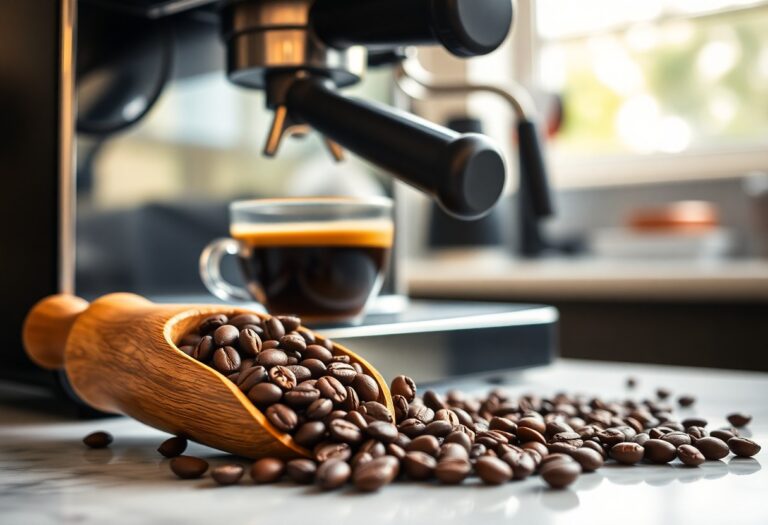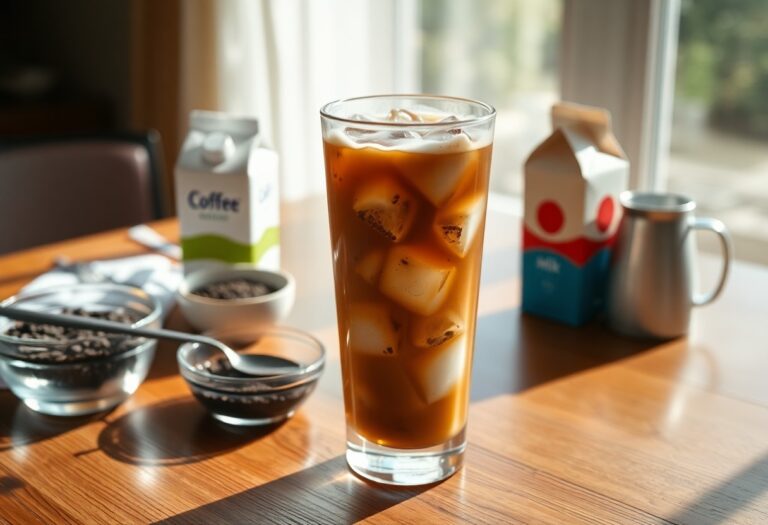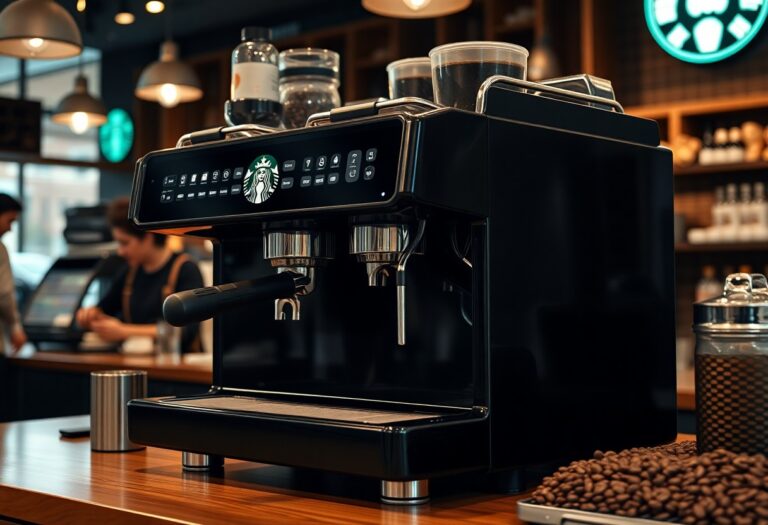What Coffee Powder to Use for an Espresso Machine – Fine Grind
With the right coffee powder, your espresso machine can brew the perfect cup of coffee. You should choose a fine grind to ensure optimal flavor extraction and rich crema, which is crucial for a delightful espresso. Using coarser grounds can lead to under-extraction, resulting in a weak and bitter cup. Conversely, too fine a grind can cause over-extraction and bitterness. By selecting the appropriate grind for your espresso machine, you will elevate your coffee experience and enjoy a consistently great brew.

Key Takeaways:
- The grind size for espresso should be fine, resembling granulated sugar, to allow for optimal extraction of flavors.
- Using fresh coffee beans and grinding them shortly before brewing enhances the espresso’s freshness and taste.
- Experimenting with different coffee blends and roasts can lead to discovering unique flavors in your espresso.
- Ensure your espresso machine is set up correctly to complement the fine grind of coffee for the best brewing results.
- Consistency in grind size is key to achieving a balanced extraction and preventing sour or bitter tastes in the espresso.

The Art of Finely Grinding Coffee for Espresso
Mastering the fine grind for espresso is imperative to achieve that rich, full-bodied flavor that coffee aficionados crave. The process involves more than simply turning your grinder to the right setting; it’s about understanding how grind size affects extraction and flavor development. Each coffee bean has unique characteristics, making fine-tuning your grind an art form that can elevate your espresso to new heights.
The Role of Grind Size in Espresso Extraction
Grind size directly influences the extraction rate of your espresso. A finer grind increases the surface area of the coffee, allowing water to extract flavors more efficiently during the brewing process. Ideally, the water should flow through the coffee at a rate that balances extraction time and pressure, achieving that harmonious taste you desire. If the grind is too coarse, you risk under-extraction, leading to a sour taste; if too fine, over-extraction leaves your espresso bitter.
Key Characteristics of a Fine Grind
A fine grind resembles powdered sugar or flour, promoting quick extraction while creating a rich crema on your espresso. It should feel silky to the touch and clump slightly when squeezed, ensuring it packs easily into the portafilter. Coffee grounds of this consistency also contribute to creating the right resistance during the brewing cycle, impacting overall pressure and flavor.
For optimal results, the grind should achieve a balance between texture and particle uniformity. A consistent fine grind ensures that water flows evenly through the coffee bed, preventing channeling that can lead to uneven extraction. The ideal grind for espresso not only enhances flavor clarity but also fuels the desirable stability of the rich, velvety crema. Experimenting with various beans while fine-tuning your grind can further reveal the complexities of your chosen coffee, resulting in a personalized espresso experience that excites your palate.
Espresso Machines: Compatibility and Coffee Types
Understanding your espresso machine’s compatibility with various coffee types is key to brewing a great shot. Not all machines can handle every grind, so matching your espresso machine with the right coffee type ensures optimal extraction and flavor. Here’s a quick look at some common types:
| Coffee Type | Compatibility |
| Light Roast | Generally works well with fine grind |
| Medium Roast | Suitable for various espresso machines |
| Dark Roast | Best for machines with lower pressure |
| Single Origin | Ideal for those seeking unique flavors |
| Blends | Great for versatile espresso shots |
Knowing your espresso machine and its preferences will lead to a more satisfying brewing experience. For more insights, check out this I bought an espresso machine, help me choose a ground … thread.
Ideal Coffee Beans for Espresso Use
Choosing the right coffee beans is important for espresso brewing. Look for beans specifically labeled as espresso, as these are often roasted to bring out rich flavors under pressure. Beans that are medium to dark roast tend to work well, while light roast might require adjustments in grind and extraction time to reach optimal flavor. Your choice of coffee beans will significantly affect the final taste of your espresso.
Specialty vs. Commercial Coffee Powders
The distinction between specialty and commercial coffee powders can impact your espresso experience significantly. Specialty coffee focuses on high-quality beans, often sourced from specific regions with unique flavor profiles. In contrast, commercial coffee generally prioritizes mass production, which may compromise flavor. Your preferences and budget will largely determine which type you choose.
Specialty coffee powders, crafted with care, usually undergo stringent quality assessments, ensuring that you receive coffee with superior taste and aroma. These powders tend to result in a more nuanced flavor, making them far more suitable for espresso machines that extract complex flavors. On the other hand, while commercial options might be more accessible and affordable, they can lead to a less satisfactory espresso experience. Investing in quality beans, even if they’re specialty, can elevate your daily brew to exceptional heights, ensuring every shot is flavorful and fulfilling.
Mastering the Grind: Tools and Techniques
Your journey towards a perfect espresso begins with mastering the grind. This process involves both choosing the right tools and perfecting your technique. The grind’s texture is necessary for extraction, with a fine grind being optimal for espresso machines. To learn more about specific coffee selection for espresso, check out What Coffee to Use for Espresso Machine? (Complete Guide).
Essential Grinding Equipment for Home Brews
For crafting the ideal espresso, you’ll need a quality burr grinder. These grinders ensure an even grind, vital for consistent extraction. Blade grinders can lead to uneven particle sizes, affecting flavor. A scale is also useful for measuring coffee accurately, as a standard ratio is about 18-20 grams of coffee per 36-40 ml of water. Investing in reliable equipment is a step towards elevating your home brew experience. Thou.
Expert Tips for Achieving the Perfect Fine Grind
To achieve a fine grind that complements your espresso machine, start with fresh, high-quality coffee beans. Adjust your grinder settings as needed; the grind should feel like flour, not sand. Pay attention to the amount you use and ensure you’re consistently measuring for each shot. Try different beans and roast levels to discover your personal favorites, and take notes during the process to refine your technique. Thou.
- Fresh coffee beans yield the best results.
- Quality burr grinders are necessary for uniformity.
- Measure your coffee precisely for consistency.
- Experiment with different beans to find your ideal flavor.
Crafting the Ultimate Espresso: Beyond Just the Grind
Achieving the richest flavors and aromas in your espresso relies on more than just the grind size. Attention to freshness, storage methods, and the balance of brew time with temperature can enhance or hinder your coffee experience. Each element plays a role in ensuring you extract the best essence from your chosen beans, leading to that perfect cup that meets your expectations.
Importance of Freshness and Storage of Coffee Powder
Freshness is paramount when it comes to espresso. Coffee begins to lose its flavor shortly after being ground. Storing your coffee powder in an airtight container, away from light, heat, and moisture, preserves its aromatic oils and prevents staleness. The optimal use window for ground coffee is typically within two weeks of grinding for the best results.
Balancing Brew Time and Temperature with Grind Size
The relationship between brew time, temperature, and grind size is integral to your espresso’s quality. A finer grind promotes quicker extraction, but if the brew time is too short or temperature too low, you may end up with an uneven flavor. Conversely, if the grind is too fine and the brew time excessive, your espresso could taste bitter due to over-extraction. The right balance leads to a harmonious flavor profile.
Balancing Brew Time and Temperature with Grind Size
| Grind Size | Recommended Brew Time and Temperature |
| Fine | 25-30 seconds at 90-95°C (194-203°F) |
| Medium-Fine | 28-32 seconds at 92-94°C (198-201°F) |
| Medium | 30-35 seconds at 92-96°C (198-205°F) |
Monitoring the extraction process plays a substantial role in perfecting your espresso technique. Adjusting your grind size influences extraction efficiency; for instance, if you’re achieving rapid extractions, shifting to a slightly coarser grind can slow down the process, enhancing flavor complexity. Conversely, if extraction is sluggish, a finer grind can increase the surface area of the coffee, improving flow and flavor release. Balancing all variables to suit your taste—experimenting with both grind size and brew conditions—ensures you master the art of espresso making.
Common Pitfalls: Avoiding Mistakes in Espresso Preparation
Common pitfalls in espresso preparation can lead to disappointing results. Issues such as incorrect grind size, insufficient tamping pressure, or inaccurate dosing may ruin your shot. Observing precise techniques during the entire process will help you avoid these mistakes and ultimately improve the quality of your espresso. Stay attentive to each step, and enjoy the learning journey toward brewing excellence.
Over-grinding vs. Under-grinding: Finding the Sweet Spot
Achieving the perfect grind size is a balancing act. Over-grinding your coffee can cause excessive bitterness due to over-extraction, while under-grinding can lead to sour flavors and weak espresso. Experimenting with different grind sizes is imperative in finding that sweet spot where the flavors harmonize, offering a full-bodied, rich shot. The best approach is to start with a medium-fine grind and adjust as necessary based on your taste preferences and equipment.
Signs You’re Using the Wrong Grind for Your Machine
Watch for specific signs that indicate you’re using the wrong grind size. If your espresso takes too long to brew or flows too quickly, it could signal an issue with the grind. A bitter taste or overly sour notes also points toward grind inconsistencies. Well-extracted espresso should pour with a rich crema and balanced flavor profile, so keep an eye on these indicators to ensure your grind is correct.
Pay close attention to the extraction time; a well-pulled shot typically takes about 25-30 seconds. If your shot pulls faster than that, your grind may be too coarse, causing weak, under-extracted flavors. On the flip side, if it takes longer, your grind might be too fine, leading to bitterness. Proper adjustments based on these signs will help you dial in your grind size, ultimately achieving a satisfying espresso experience.
Conclusion
Now that you understand the importance of selecting the right coffee powder for your espresso machine, focus on using a fine grind for optimal extraction and flavor. By choosing high-quality beans and grinding them to a fine consistency, you enhance your espresso experience, allowing rich aromas and buttery textures to shine through. Make sure to experiment and adjust your grind size based on your taste preferences to find the perfect cup that meets your expectations. Happy brewing!
FAQ
Q: What type of coffee beans are best for making espresso?
A: When making espresso, it’s best to use high-quality Arabica beans or a blend of Arabica and Robusta beans. Arabica beans typically offer a sweeter and more nuanced flavor, while Robusta can add a richer, more robust taste and a thicker crema. Look for beans that have been roasted specifically for espresso to enhance the overall flavor.
Q: How fine should the coffee grind be for an espresso machine?
A: The coffee grind for an espresso machine should be very fine, similar to the texture of table salt or powdered sugar. This fine grind helps to extract the flavors more efficiently during the short brewing time of espresso. If the grind is too coarse, the water will flow through too quickly and under-extract the coffee, leading to a sour taste.
Q: Can I use pre-ground coffee for my espresso machine?
A: While it is possible to use pre-ground coffee for espresso, it’s recommended to grind your own coffee for the best flavor and freshness. Pre-ground coffee may not always have the ideal grind consistency for espresso and can lead to a less than optimal extraction. If you do use pre-ground coffee, ensure it’s specifically labeled for espresso use.
Q: What brands of coffee are recommended for espresso?
A: There are several well-known brands that offer excellent coffee for espresso. Some popular choices include Lavazza, Illy, Peet’s Coffee, and Stumptown. Many local roasters also provide high-quality espresso blends. It’s beneficial to explore different brands and blends to find the one that suits your taste preferences best.
Q: How should I store coffee powder to maintain freshness?
A: To maintain the freshness of your coffee powder, store it in an airtight container away from light, heat, and moisture. A cool, dark place such as a pantry or cupboard is ideal. For extended freshness, consider keeping the coffee in the freezer, but make sure to portion it out beforehand to avoid repeated exposure to air each time you retrieve some.







